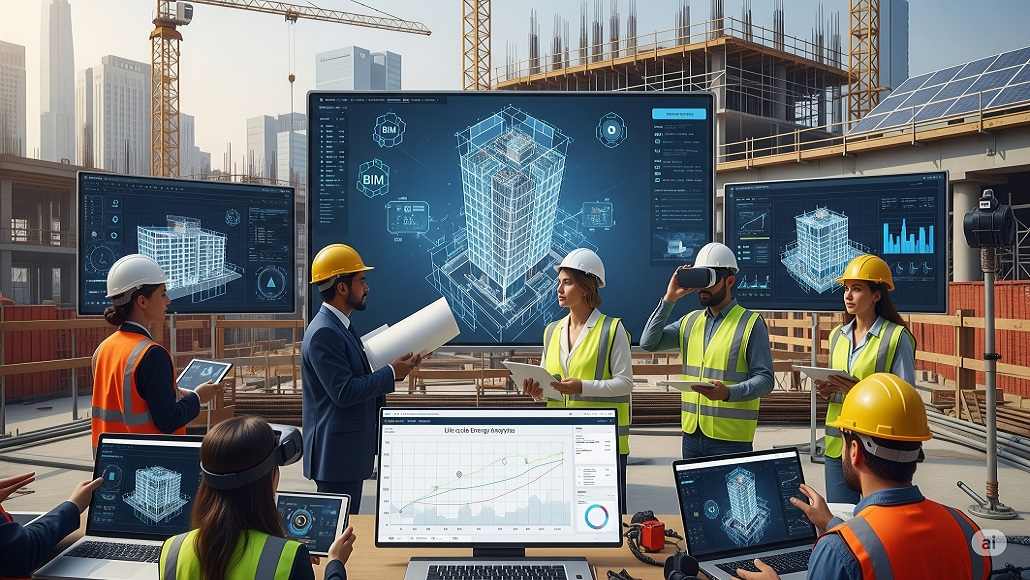In today’s times, the construction industry is experiencing an unprecedented digital transformation, which is driven due to the fast adoption of building information modelling (BIM). As a mainstay of modern project management, design, as well as construction workflows, the influence of BIM goes beyond just digital drafting to encompass overall life-cycle management of buildings as well as infrastructure. With the global construction sector’s rising focus when it comes to sustainability, efficiency, and cost reduction, BIM has cropped up as a critical enabler of these strategic objectives.
Market overview along with growth trajectory
In 2025, the global BIM market was valued at almost $10.07 billion, a figure that highlights its vital role within the broader construction technology spectrum. Industry forecasts happen to project a CAGR of almost 14% between 2025 and 2032, thereby reaching an anticipated $25 billion by the end of the forecast period. This kind of dramatic expansion is due to numerous intertwined elements, which range from regulatory mandates for BIM adoption on large-scale projects to growing investment in sustainable infrastructure and even the proliferation of smart city initiatives.
This kind of growth in market valuation goes on to reflect the expanding application landscape of BIM, right from initial designing and planning to facilities management, construction management, and even decommissioning. That fast adoption of building information modelling is being viewed as a necessity and not a choice enhancement, specifically as governments as well as industry bodies enforce certain digital benchmarks in order to enhance the transparency of projects, reduce the wastage, and even speed up the delivery schedules.
Drivers when it comes to market growth
The major drivers that are fueling the rapid growth of BIM happen to be multifaceted. Governments across the world are executing policies that mandate or even incentivize the usage of BIM on projects that are publicly funded. The General Services Administration (GSA), along with various other state departments, now needs BIM when it comes to their infrastructure projects that are exceeding certain specific thresholds, thereby throttling the demand across the continent.
It is well to be noted that beyond the regulatory pressures, the focus of the industry on sustainability has indeed accelerated the adoption of BIM. By way of facilitating accurate energy modelling, material optimization, and even life-cycle evaluation, BIM happens to support green building practices, which are crucial to the climate commitments of the world.
Apparently, technological innovations within the BIM spectrum, like cloud-based platforms, real-time collaboration tools, and even AI-enabled analytics, happen to be making it much easier for firms to roll out as well as scale the BIM solutions. This kind of technological convergence elevates the data sharing, reduces the costs, and cuts down on project timelines, thereby making BIM an indispensable tool when it comes to competitive advantage.
The regional market dynamics
When we talk of the North American market, it has gone on to exhibit the strongest growth, which has been propelled due to a mature infrastructure sector, strict building codes, and also a regulatory environment, which is proactive and emphasizes digitization.
Europe, on the other hand, due to its ambitious targets in order to attain climate neutrality by 2050, happens to be investing heavily when it comes to BIM rollout, especially in countries like Germany, the UK, and France. These nations are making utmost use of BIM when it comes to large-scale projects like transport corridors, urban regeneration, and renewable energy facilities, which require advanced digital tools when it comes to coordination as well as sustainability evaluation.
It is well to be noted that in Asia Pacific, faster urbanization along with infrastructure development are indeed driving the highest CAGR. It is expected to be over 17% throughout the forecast period. China happens to remain the dominant player, which is integrating BIM into the Belt and Road Initiative as well as other national construction standards. India, on the other hand, has also announced numerous initiatives that promote BIM adoption across public projects, thereby further throttling the regional growth.
Segmentation along with technological innovation
The market segmentation goes on to reveal diverse application areas, which reflect maturity as well as specialization within the BIM spectrum. When it comes to industry sectors, the commercial, along with residential, segments are leading due to their substantial project volumes along with regulatory requirements when it comes to digital planning. Infrastructure projects like tunnels, bridges, and railways are fast catching up as governments push for digital tendering as well as project management.
Within the BIM software spectrum, the core modules happen to include clash detection, 3D modeling, and cost estimation, along with life-cycle management. Increasingly, there are advanced analytics and also AI-enhanced platforms that are offering productive insights, risk evaluation, and automation of the routine tasks. Cloud-based BIM solutions are gaining a lot of ground when it comes to remote partnerships, specifically in areas in which distributed teams happen to be the norm.
It is well to be noted that energy-efficient building design is gaining a lot of prominence with BIM integrated into the building performance simulation (BPS) software. This enables the architects as well as engineers to optimize lighting, cooling, heating, and ventilation systems much earlier in the project life cycle, thereby leading to sustainability benefits, which are measurable.
Apparently, emerging trends happen to include the integration of IOT sensors within BIM models by creating smart BIM systems that track real-time building performance. Digital twin technology, which happens to create a dynamic virtual replica in terms of physical assets, is also gaining ground, thereby helping with predictive maintenance as well as functional optimization.
Sector-specific insights along with industry quotes
It is worth noting that industry leaders highlight the transformative potential that BIM has, with many citing it as the backbone when it comes to digital transformation within construction. One of the senior executives at a leading global engineering firm opines that BIM has actually become a fundamental requirement, for it provides competitive project delivery by way of increased efficiency, savings in costs, and also better stakeholder collaboration as the primary advantages.
Interestingly, the construction sector’s embrace when it comes to sustainability is also evident in the role of BIM when it comes to green building practices. By way of helping precise material calculation along with life-cycle evaluation, BIM decreases the waste and optimizes the resource utilization. One of the well-known architecture firms stressed that integrating BIM along with environmental data speeds up the design of low-carbon as well as energy-efficient buildings, thereby aligning with the global climatic objectives.
So what are the market trends, and what is the future outlook?
Going forward, the integration of BIM along with emerging digital technologies is going to drive the next phase of growth. The rise of 5G connectivity is going to help seamless real-time data sharing along with remote project oversight as well as AI-driven automation. These advancements are going to decrease the project duration, enhance the safety, and also help with more sophisticated simulations across the design as well as construction phases.
Apparently, the adoption when it comes to digital twins – virtual counterparts if we talk of physical assets—is going to become standard practice, with upgrades, supporting maintenance, and life-cycle management coming to the fore. This kind of approach syncs with the rising emphasis when it comes to asset longevity along with sustainability, especially when we talk of infrastructure projects.
Besides this, the ongoing development when it comes to open standards as well as interoperability protocols is going to foster a more connected BIM spectrum, thereby helping with seamless data exchange throughout platforms as well as stakeholders. Governments, along with industry groups, are also advocating in terms of BIM mandates, and there are many aiming for full adoption across all public projects by the end of this decade.
There are emerging technologies like blockchain along with AI, which are further revolutionizing the collaborative potential of BIM. Blockchain’s decentralized ledger system can very well transform how project data gets verified and shared throughout stakeholders by ensuring transparency when it comes to contractual compliance. On the other hand, AI-powered analytics are enabling productive modelling within BIM environments, therefore helping the teams to anticipate clashes or inefficiencies much before the groundbreaking takes place. The growth of digital twin integration is also creating living models that evolve along with structures throughout their life cycle. As the 5G networks also expand, real-time BIM collaboration in pacing up the virtual reality is going to become commonplace and help architects on different continents to manipulate the same model synchronously.
Conclusion
The fact is that the building information modelling market happens to be on a clear upward trajectory and is fueled due to technological innovations, regulatory mandates, and also a worldwide push towards sustainable practices in construction. Anticipating almost US$10 billion in 2025, the market is expected to expand almost fourfold by 2032 and reach somewhere around US$25 billion. This kind of digital transformation within the construction industry happens to promise growing efficiency, sustainability, and cost savings, thereby aligning with industry priorities as well as wider societal objectives.
































